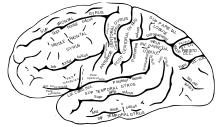Gyrus
The gyrus (plural gyri , Latinized form from Greek γύρος gýros [ ˈgyːrɔs ], German 'round' , 'bend', 'round', 'hem', 'edge', here in the sense of 'winding') is a term from the Surface anatomy of the brain . It represents a convoluted brain protruding from the brain mass.
The individual gyri are separated from one another by fissures (furrows) and sulci (trenches). Through these structures is in the wholesale and the cerebellar cortex , the principle of surface enlargement realized.
The formation of the gyri on humans takes place as early as the 24th week of pregnancy (SSW), and full gyration is usually achieved by the 32nd week of pregnancy. The brain surface of a newborn is about 679 cm², of which about 61% is located within the sulci. When the gyri are fully developed in adulthood , their number increases and the surface of the brain increases to about 1600 cm².

